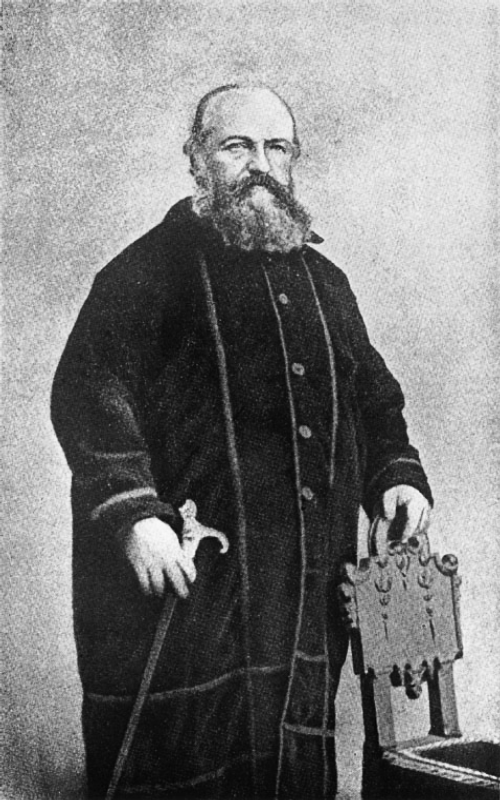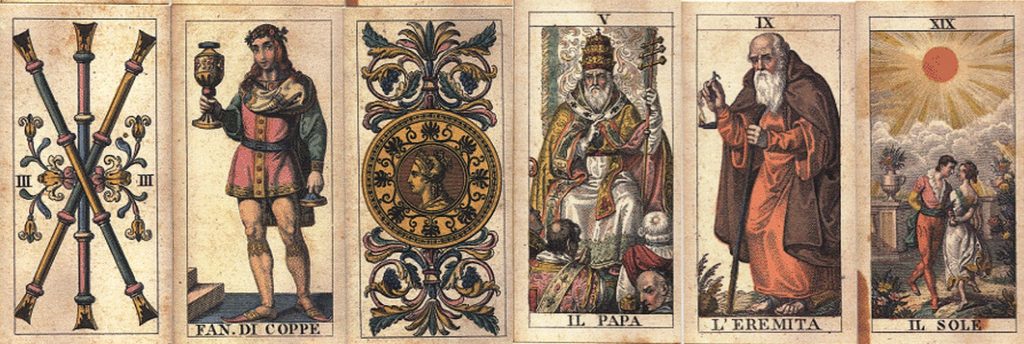Origins of the Tarot
Origins of the Tarot was an inspirational article published by the Lifewave Meditation Group of the 1980s and form part of the esoteric tarot course of that time.
The Tarot (or Tarocchi, Taro, Taroc) is a pack of cards, consisting of 78 different symbolic designs divided into two distinct groupings. One group consists of 22 cards for the major arcana or major trumps. The remaining 56 are the minor arcana and are composed of four suits each with ten numerals and four court cards. The court cards are King, Queen, Knight and Knave or Valet. The suits are Swords (military), Cups (sacerdosy or priest craft), Wands (agricultural class) and Pentacles or Coins (commerce, merchant class). In the moden pack of playing cards these suits are respectively spades, hearts, clubs and diamonds. The Tarot differs from playing cards in that the latter have retained only 52 cards, all drawn from the minor arcana.
The origins of the Tarot are shrouded in mystery. Theories and speculations abound, but hard facts are few and far apart. The earliest cards historically known to exist were from the far eastem countries, dating from about the 11th century, but their designs are not now known. In Europe, cards were known to exist in the 14th century, but were apparently used for amusement and gambling. Their introduction into South Europe is accredited to Arabia, who probably brought them from India. None of these very early European cards still exist but it is known that they were based on a four suit system, whereas cards in use in the far east and India were based on anything up to ten suits.
Though historically playing cards were believed to exist before the introduction of Tarot cards, it can safely be assumed that they were based on and grew out of the Tarot system. It is probable that the Tarot cards were part of the magical and philosophical lore secured by the Knights Templars from the Saracens or one of the mystical sects then flourishing in Syria. Once back in Europe, the Templars, to avoid religious persecution might have concealed the arcane meaning of the symbols by introducing the cards ostensibly as a device for amusement and gambling.
At about the same time, gypsies were spreading into Europe using the card system for divinatory purposes. Gypsies claim their ancestry can be traced back to Egypt and there is a legend that they are descended from priests who guarded the secrets and rites of Serapis in Alexandria. The priests were supposed to have saved a few of the priceless books from the famous Library at Alexandria before they were all destroyed by fire and the Tarot may be a distillation of some of the occult knowledge obtained from these volumes and deliberately hidden in symbolic hieroglyphs.
The esoteric knowledge of the Egyptians is said to have been written down in books whose authorship was attributed to Thotto. These books were almost certainly written in symbolion – the keys to which would be held only by initiates. The outward manifestations of popular religions were merely expressions of this esoteric knowledge and the plural deities of paganism were as no more than attributes of the power of the one whose clearest and simplest emblem was the Sun.
In Europe it seems unlikely that the Tarot cards or their true significance were known of outside of Secret Societies; Paracelsus of Hohenheim (1493 – 1541) makes no mention of them in his enumeration of the divinatory arts, and it is not really until the 18th century that the Tarot becomes at all widely known.
The Tarot is a vital element in early Rosicrucian symbolism and is perhaps the basis of the universal knowledge which they claimed to possess. Tarot symbolism has also been discovered in the many writings of Sir Francis Bacon( the probable author of the Shakespearean writings). It is also to be found in Masonic Symbolism.
 Many writers have linked the various cards of the major arcana with the planets, the signs of the Zodiac and with certain universal laws of creation. For example, the Juggler symbolises the Sun, creation, will and power; Death is Satum, Time and Transformation.
Many writers have linked the various cards of the major arcana with the planets, the signs of the Zodiac and with certain universal laws of creation. For example, the Juggler symbolises the Sun, creation, will and power; Death is Satum, Time and Transformation.
The Tarot cards can be considered in the following ways; as separate and complete hieroglyphs, or symbols, each of which represent a principle or law in nature (and therefore also in man) and as agents of principles which act upon and effect each other. The symbolism of the cards, particularly the major arcana, is very profound and it is this aspect of Tarot that the student of occultism would apply himself to, Eliphas Levi wrote:
“an imprisoned person with no other book than the Tarot, if he knew how to use it, could in a few years, acquire universal knowledge and would be able to speak on all subjects with unequal learning and inexhaustible eloquence”.
With the symbolism also inherent in the Qabalah and in old scriptural writings, it can be readily understood why symbolism is one of the Seven Keys and an essential Key in order to understand the mysteries of creation.
The Tarot is also an oracle, and it is in this divinatory way that it is generally used. Writers and cartomancers do not understand how this aspect of the Tarot works, only that it does. Most town library archives will have books on the Tarot and it is quite easy to learn how to use the cards for divinatory purposes. For those who want to study the symbolism of the cards, should refer to the previously, issued notes on the Qabalah and study both in conjunction.
Sant Aja Anandji
ORIGINAL DOCUMENT

